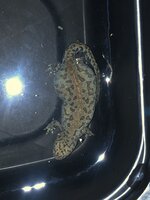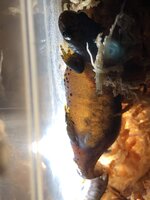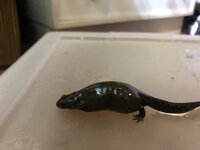So quick update, I took her to the vet and basically they can't do anything for her due to her small size. The exotic vet here has never really dealt with amphibians before, especially newts. He did offer to do x-rays and such, but he warned about the costs, that the images might not be clear, and that if he took samples he might seriously hurt her. I could tell he never dealt with caudates as he suggested keeping it warmer than the max 20C I try to aim for. In the end, the vet thinks its an impaction.
Personally I think its bloat or edema, but I am not ruling out what the vet says as this happened rather quickly and its localized around her pelvic region going to try a few things. What throws me off is she is very active and still willing to eat, which go against what are probably the 2 biggest symptoms of impaction, which is lethargy and loss of appetite. The way I see it, the newt may have organ failure and could be on its way out in the worst case scenario, thus treatment may be all in vain. However, it presents itself as a good learning experience in how to properly tackle this issue for myself and anyone else in the future. Regardless, I am going to try my best to see if I can cure her! I am prepared for euthanasia, but that is an absolute last resort.
To start off the treatment, I will hospitalize her, and treat her as thought the vet was right with impaction. I'll place her in a cool area at first and see if she has a bowel movement. I'm pretty sure she had one when we got back from the vet as I saw a rather white bit of feces on my plants, but its hard to say if it was her. Wish she had that before leaving for the vet! I will also being getting supplies and chemicals for ARS, or Amphibian Ringer's Solution. It may help, it may not. But its worth a try to start treatment and point me in the right direction of what is happening.
Its unfortunate that our hobby is as niche as it is, it makes diagnosing these things hard. Especially now that this forum seems dead! I am not pointing fingers or saying people should pipe up, but rather anybody who uses this forum should post their experiences, good or bad, no matter how controversial or mundane, like I am to better help out hobbyists in diagnosing disease and treatment, and just performing general husbandry of their pets. So I will be posting my 'journey' for others to see. Wish me luck!





